Samsung EVO Plus microSDXC UHS-I 512GB Memory Card Capsule Review
by Ganesh T S on May 10, 2019 9:00 AM EST- Posted in
- Storage
- Samsung
- flash
- Memory Cards
- microSDXC

As content capture devices are recording ever-higher bitrate videos and higher resolution photos, high capacity memory cards are increasingly in demand. Everything from smartphones to game consoles to PCs use memory cards in some fashion or another, and storage needs are having no trouble keeping up with gains in storage capacity. And, with microSD cards having largely dominated the memory card market, advances here are largely setting the pace for the industry from a consumer point of view.
In our series of memory card reviews, we recently looked at the PNY Elite microSDXC UHS-I 512GB and the SanDisk Ultra microSDXC UHS-I 400GB cards. Today, we are adding the performance numbers of Samsung's play in that market segment - the Samsung EVO Plus microSDXC UHS-I 512GB.
Introduction
SD (Secure Digital) cards were introduced in 1999, as a follow-up to the existing MultiMediaCards (MMCs). Its miniature form-factor enabled it to gain traction even in areas dominated by CompactFlash. Its popularity spawned two follow-ups retaining the same form-factor - starting with SDSC in 1999 for capacities between 1MB and 2GB, we got SD High Capacity (SDHC) in 2006 (up to 32GB) and SD eXtended Capacity (SDXC) in 2009 (up to 2TB). The cards also come in various sizes - standard, mini, and micro. Currently, the standard and micro sizes are more popular in the market. SD's popularity and affordability has meant that almost all consumer cameras come with a SD card slot.
A number of high-capacity (512GB capacity class) microSDXC cards have been introduced recently. Starting with the 400GB SanDisk Ultra microSDXC UHS-I card ($66 at $0.17/GB) introduced in August 2017, we now have the Integral 512GB and the PNY Elite 512GB in the market as well. At Computex 2018, we also saw plans from ADATA and Team Group to sell 512GB microSDXC cards. With the industry migrating to 3D NAND, the capacity per die has seen significant increase, allowing for microSDXC cards to reach these capacities.
Samsung was a bit late to the party, launching the 512GB version of the EVO Plus in February 2019. The EVO Plus series of microSDXC cards is UHS-I rated with a U3 (UHS Speed Class) rating. Unlike the SanDisk Ultra 400GB card, the Samsung EVO Plus doesn't claim any App rating (despite the prominent photograph of an Android smartphone in the packaging of the card). The card does carry a Class 10 Speed Class / U3 UHS Speed Class rating, guaranteeing a minimum sequential write speed of 30 MBps.
Samsung supplied us with a retail sample of their EVO Plus microSDXC 512GB card to put through our comprehensive memory card evaluation routine. Prior to taking a look at the performance numbers, we take a look at the testbed setup and evaluation methodology.
Testbed Setup and Testing Methodology
Evaluation of memory cards is done on Windows with the testbed outlined in the table below. The USB 3.1 Gen 2 / Thunderbolt 3 Type-C port enabled by the Intel Alpine Ridge controller is used as the host port for benchmarking purposes on the testbed side. uSD cards utilize the Lexar Professional Workflow SR2 SDHC / SDXC UHS-II USB 3.0 Reader along with a microSD to SD adapter. The reader was placed in the Lexar Professional Workflow HR2 hub and uplinked through its USB 3.0 port with the help of a USB 3.0 Type-A female to Type-C male cable.
| AnandTech DAS Testbed Configuration | |
| Motherboard | Intel NUC8i7HVB |
| CPU | Intel Core i7-8809G |
| Memory | Corsair Vengeance DDR4 SODIMM 32 GB (2 x 16GB) DDR4-2666 @ 18-19-19-39 |
| OS Drive | Intel Optane SSD 800p SSDPEK1W120GA (118 GB; M.2 Type 2280 PCIe 3.0 x2 NVMe; Optane |
| SATA Devices | Intel SSD 545s SSDSCKKW512G8 (512 GB; M.2 Type 2280 SATA III; Intel 64L 3D TLC) |
| Add-on Card | None |
| Chassis | Intel Hades Canyon NUC Chassis |
| PSU | Lite-On 230W (19.5V @ 11.8A) External Power Adapter |
| OS | Windows 10 Pro x64 |
| Thanks to Intel and Corsair for the build components | |
Details of our traditional DAS testbed can be found here. However, starting late last year, we started noticing abnormally low performance numbers for certain devices and general instability after attempting Thunderbolt firmware upgrades (while trying to make an eGFX enclosure work with the system). Starting with the Plugable USBC-NVME storage bridge review, we have temporarily moved to using the Hades Canyon NUC (described above) as our testbed for direct-attached storage units.
Our review workflow for memory cards test the following aspects.
- Sequential writes and reads (fresh pass)
- robocopy benchmarks (AnandTech DAS Suite) with performance consistency evaluation
- PCMark 8 Storage Bench (selected workloads)
- Sequential writes and reads (used pass)
- CrystalDiskMark sequential workloads (used and refreshed)
The justification for each of the tests and the details of how they are framed is discussed here.
Performance - Sequential Accesses
Samsung claims read and writes of up to 100 MBps / 90 MBps respectively, but real-world speeds are bound to be lower. In fact, writes can sometimes be much slower. For most applications, that really doesn't matter as long as the card is capable of sustaining the maximum possible rate at which the camera it is used in dumps data. We use fio workloads to emulate typical camera recording conditions. We run the workload on a fresh card, and also after simulating extended usage. Instantaneous bandwidth numbers are graphed. This gives an idea of performance consistency (whether there is appreciable degradation in performance as the amount of pre-existing data increases and / or the card is subject to wear and tear in terms of amount and type of NAND writes).
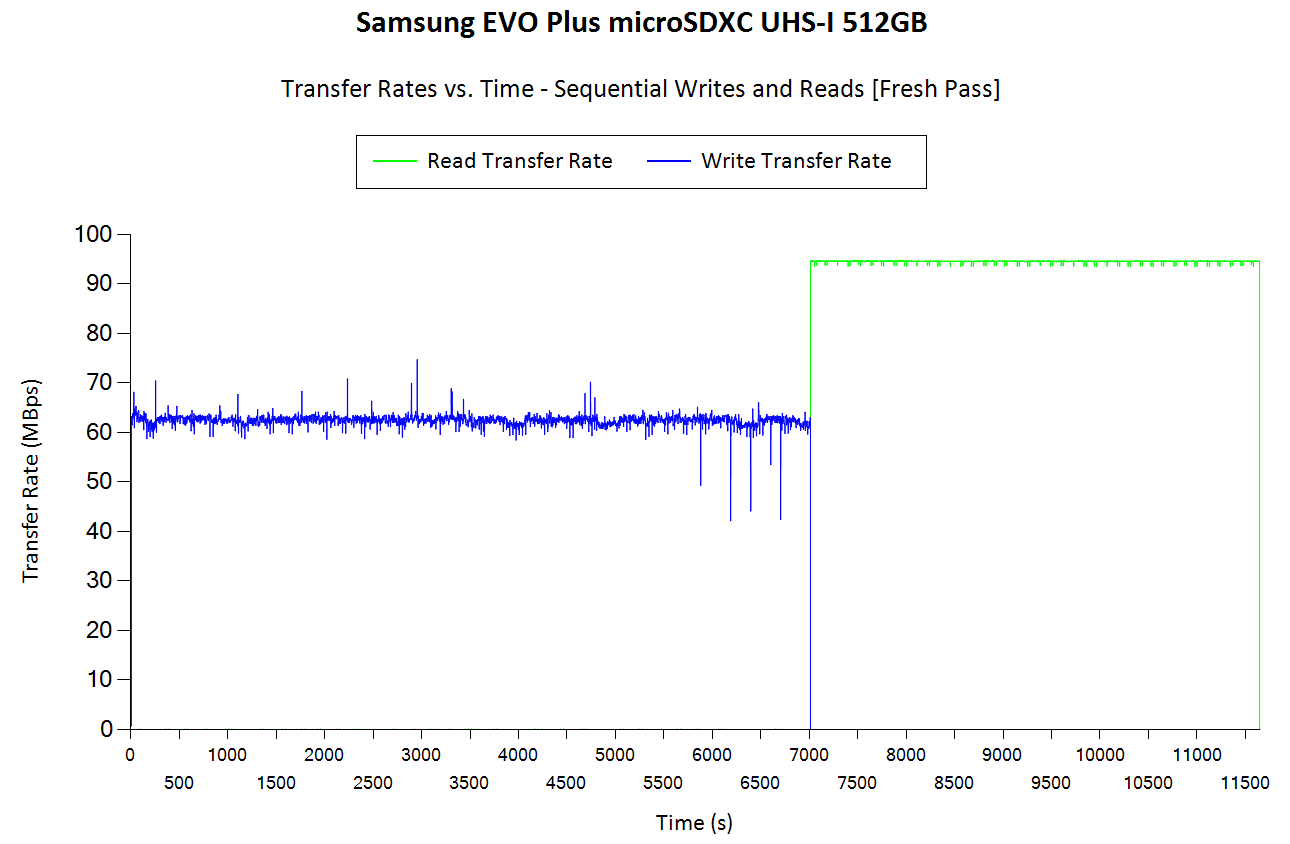
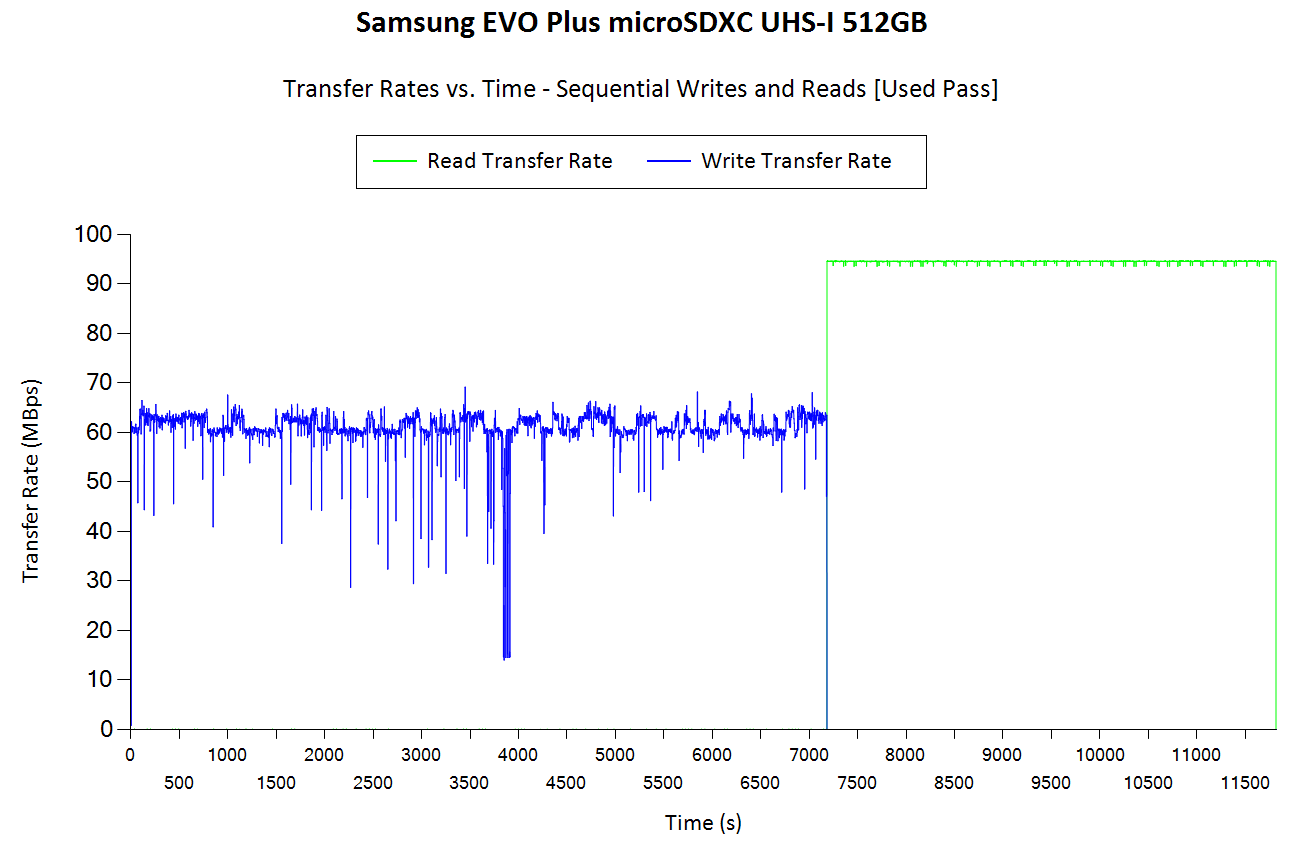
The EVO Plus microSDXC has no issues in meeting the 100 MBps numbers on the read side. However, on the writes, we see the fresh pass results coming in at around 64 MBps, and being quite consistent too. After being subject to extensive traffic, we see that the card starts to experience hiccups under heavy stress. The performance profile is no longer consistent, though the card tries to keep the performance steady around 64 MBps. The writes drop down to as low as 20 MBps a few times, but, for most of the workload duration, the valleys are above the 30 MBps mark required by the UHS Speed Class 3 rating.
Compared to other cards, the performance consistency of the Samsung EVO Plus is commendable. The absolute numbers are also better than cards like the SanDisk Ultra 400GB. However, the valleys in the used pass are worse for the EVO Plus compared to the SanDisk card. The Samsung card is of higher capacity compared to the SanDisk one, and, therefore, the PNY card is a more apples-to-apples comparison. In absolute numbers, the Samsung EVO Plus is far ahead of the PNY card. In terms of performance consistency, we actually see the PNY card maintaining almost the same performance in the used state compared to the fresh state.
Performance - AnandTech DAS Suite
Consistency
The AnandTech DAS Suite involves transferring large amounts of photos and videos to and from the storage device using robocopy. This is followed by selected workloads from PCMark 8's storage benchmark in order to evaluate scenarios such as importing media files directly into multimedia editing programs such as Adobe Photoshop. Details of these tests from the perspective of memory cards are available here.
In this subsection, we deal with performance consistency while processing the robocopy segment. The graph below shows the read and write transfer rates to the memory card while the robocopy processes took place in the background. The data for writing to the card resides in a RAM drive in the testbed. The first three sets of writes and reads correspond to the photos suite. A small gap (for the transfer of the videos suite from the primary drive to the RAM drive) is followed by three sets for the next data set. Another small RAM-drive transfer gap is followed by three sets for the Blu-ray folder. The corresponding graphs for similar cards that we have evaluated before is available via the drop-down selection.

The Samsung EVO Plus has the best sequential write performance in its ratings class, and that shows in the above graphs. The EVO Plus completes our test suite the fastest, and has no major consistency issues between different passes of the same data.
Bandwidth
The average transfer rates for each workload from the previous section is graphed below. Readers can get a quantitative number to compare the Samsung EVO Plus microSDXC UHS-I 512GB uSD card against the ones that we have evaluated before.
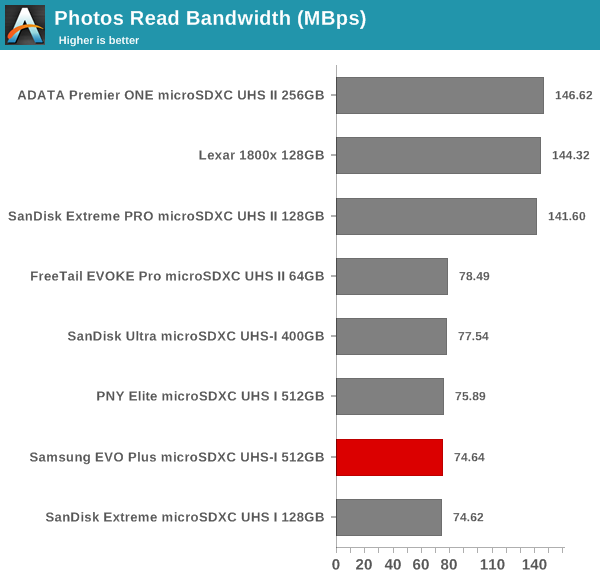
The reads are essentially a tie between all the UHS-I cards in our database. On the writes, the Samsung EVO Plus has the best numbers amongst the set of UHS-I cards across all the different capacity points.
We also look at the PCMark 8 storage bench numbers in the graphs below. Note that the bandwidth number reported in the results don't involve idle time compression. Results might appear low, but that is part of the workload characteristic. Note that the same testbed is being used for all memory cards. Therefore, comparing the numbers for each trace should be possible across different cards.

The SD controller used in the Samsung EVO Plus ensures that, despite the UHS-I rating of the card, the unit comes out on top across all the different workloads in the PCMark 8 Storage Bench. The change in the testbed may also partially contribute to the better performance, but, we do see that some entries (such as those for the SanDisk Ultra 400GB and the SanDisk Extreme UHS-I cards) for UHS-I are better than the leading UHS-II cards. Overall, the Samsung EVO Plus really stands out of the crowd in these workloads.
Performance Restoration
The traditional memory card use-case is to delete the files on it after the import process is completed. Some prefer to format the card either using the PC, or, through the options available in the camera menu. The first option is not a great one, given that flash-based storage devices run into bandwidth issues if garbage collection (processes such as TRIM) is not run regularly. Different memory cards have different ways to bring them to a fresh state.Based on our experience, uSD cards have to be formatted using the SD Formatter tool from the SD Association (after all the partitions are removed using the 'clean' command in diskpart).
In order to test out the effectiveness of the performance restoration process, we run the default sequential workloads in CrystalDiskMark before and after the formatting. Note that this is at the end of all our benchmark runs, and the card is in a used state at the beginning of the process. The corresponding screenshots for similar cards that we have evaluated before is available via the drop-down selection.

These is a slight drop in the write rate after performance restoration, with numbers similar to what we see in the sustained write workload. The performance is still better than the requirements of the claimed speed rating.
Closing Thoughts
The Samsung EVO Plus microSDXC UHS-I 512GB card successfully completed our intensive benchmarking routines. It showed the best overall performance numbers among all the high-capacity microSDXC cards in our database, surpassing the PNY Elite as well as the SanDisk Ultra. A little bit of additional consistency in the used state would be nice to have, as we see it barely managing to keep abreast of the speed rating requirements compared to the other high-capacity cards (against their claimed speed ratings).
In addition to raw performance and consistency, pricing is also an important aspect. This is particularly the case for the casual user and semi-professional markets, where the value for money metric often trumps benchmark numbers. The table below lists the price and capacity for the Samsung EVO Plus microSDXC UHS-I 512GB uSD card as well as some of the other cards we have evaluated before. The cards are ordered by the $/GB metric.
| microSD Cards - Pricing | ||||
| Card | Model Number | Capacity (GB) | Street Price (USD) | Price per GB (USD/GB) |
| SanDisk Ultra microSDXC UHS-I 400GB | SDSQUAR-400G-GN6MA | 400 | 64 | 0.16 |
| Samsung EVO Plus microSDXC UHS-I 512GB | MB-MC512GAEU | 512 | 98 | 0.19 |
| PNY Elite microSDXC UHS I 512GB | P-SDU512U190EL-GE | 512 | 116 | 0.23 |
| SanDisk Extreme microSDXC UHS I 128GB | SDSQXAF-128G-GN6MA | 128 | 31 | 0.24 |
| ADATA Premier ONE microSDXC UHS II 256GB | AUSDX256GUII3CL10-C | 256 | 142 | 0.55 |
| FreeTail EVOKE Pro microSDXC UHS II 64GB | FTUD064A10 | 64 | 61 | 0.95 |
| SanDisk Extreme PRO microSDXC UHS II 128GB | SDSQXPJ-128G-GN6M3 | 128 | 135 | 1.05 |
| Lexar 1800x 128GB | LSDMI128CRBNA1800R | 128 | 160 | 1.25 |
In terms of cost per GB, the SanDisk Ultra is currently ahead of the Samsung EVO Plus and the PNY Elite. That said, the Samsung has better write performance compared to the other two. If 400GB is enough capacity, and leading-edge UHS-I performance is not required, the SanDisk Ultra is going to be a good fit and the best value.. However if you have a little more flexibility on price and need a high-capacity card with better overall performance, then the Samsung EVO Plus gets our recommendation.


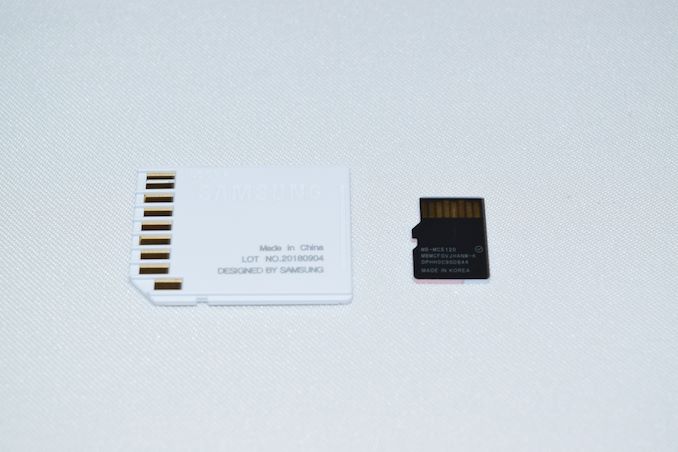
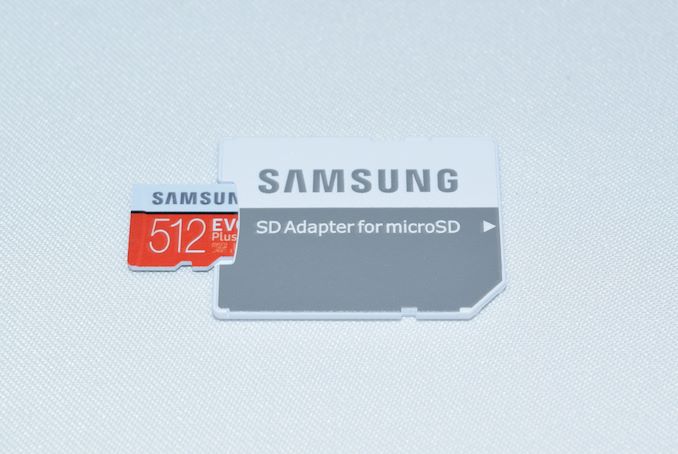








11 Comments
View All Comments
valinor89 - Friday, May 10, 2019 - link
If you buy any Samsung EVO Plus card be sure to buy them from trusted retailers as it seems fake/counterfeit cards are quite usual. It will not be long before the 512GB version is copied, if it is not already so.Opencg - Friday, May 10, 2019 - link
It's ok. I got the 4tb one so I know I'm safe0PeachNCream - Friday, May 10, 2019 - link
Yeah no kidding. There are occasional complaints about counterfeit Samsung and SanDisk cards finding their way into reputable retail channels even so you have to exercise some care.kobblestown - Friday, May 10, 2019 - link
Imagine a Beowulf cluster out of these...:https://www.youtube.com/watch?v=3frnBoqqI_Q
bubblyboo - Friday, May 10, 2019 - link
"Memory Card Capsule"Is this the only site that uses such terminology?
jtd871 - Friday, May 10, 2019 - link
You misunderstand the title: it is a 'capsule review' - a relatively brief review, as opposed to the more extensive multi-page 'full reviews' published on this site.tygrus - Friday, May 10, 2019 - link
Instead of "capsule review" try choosing from "short review" or "brief review"Skeptical123 - Saturday, May 11, 2019 - link
I wonder if they will come out with a "Samsung Pro Plus" variant.Skeptical123 - Saturday, May 11, 2019 - link
It looks like the hyperlink in "We use fio workloads to emulate typical camera recording conditions. We run the workload on a fresh card" goes to the wrong address. Also I wonder if they will come out with a "Samsung Pro Plus" parent Samsung EVO PlusLordConrad - Sunday, May 12, 2019 - link
Great, even more data that could be lost if I sneeze. Seriously though, if these memory cards get much smaller they'll be a pain in the backside to keep track of!